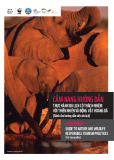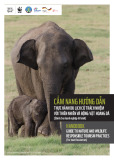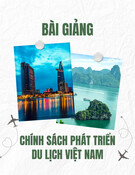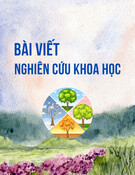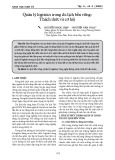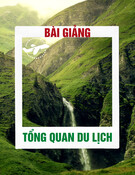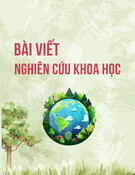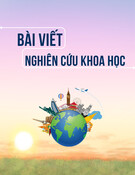
154
Đặc điểm và giá trị của du lịch tôn giáo ở Việt Nam
Nguyễn Quang Minh Triết
Tóm tắt
Với sự mở rộng toàn cu của du lịch và lữ hành, ngành du lịch của Việt Nam đã phát triển
từng ngày. Nhiều loại hình du lịch mới được khám phá và mở rộng một cách bất ngờ. Trong
điều kiện hiện nay, việc thiết kế một tour du lịch đáp ứng nhu cu của khách du lịch dường như
khó hơn. Nhiều du khách không chỉ quan tâm đến những chuyến du lịch thư giãn, giải trí mà
còn đi tour với những mục đích cụ thể khác. Một trong những số đó là tour du lịch tôn giáo,
một mô hình tour mới và tiềm năng ở Việt Nam.
Từ khoá: ngành du lịch, đặc điểm, tôn giáo, tiềm năng, khách du lịch
Features and values of religious tourism in Vietnam
Abstract
With the global expansion of travel and tourism, Vietnam’s tourism industry has
developed day by day. Many new kinds of tour are discovered and extended unexpectedly.
Designing a tour which meets the demands of tourist seems more difficult in current status.
Many tourists are interested in not only relaxing or entertaining tours but also tour in other
specific purposes. One of these is religious tour which is a new and potential tour model in
Vietnam.
Key words: tourism industry, feature, religion, potential, tourist
Introduction
With a huge base of relatively undisturbed natural resources, a rich history, and a long-
established culture, Vietnam is becoming an attractive tourism destination in Asia. Not only the
numbers of foreign tourists who come to Vietnam are more and more increasing rapidly but
also the domestic tourists in Vietnam are rising considerably. Vietnam is mixed by Western and
Eastern culture, so religion in Vietnam is diversified. According to the 2014 survey of Pew
Research Center Washington D.C, most of the Vietnamese practice indigenous religions
(ancestor worship). Buddhism and Catholic are 2 important religions in Vietnam. To meet the
spiritual demand, many tourist companies have developed religous tours, especially for
Buddhist and Catholic. Although, this kind of tour has recently formed, it brings a very large
profit for tourist companies in Vietnam. Understanding the characteristics of religious tourist is
vital to comprehending the challenges for the emerging tourism industry in Vietnam.
Literature review
Tourism
In Vietnam, official definition of tourism was announced by tourism decree-law in 1999
“Tourism is the activities of human outside their usual environment to satisfy the demands for
visisting, relaxing and enjoying convalescence”. So, when connecting all of these definitions,
we can recognize that tourism just occurs when travelers have specific purposes. Each trip has
one and only one main purpose though a visitor can also undertake secondary activities







